Hi all,
Below are the private/public funding distribution in Korea, Japan. Based on the data from OECD, Japan has a higher and stable public funding ratio, and public funding in Korea is catching up. For China, the detailed breakdown indicates that public funding is also increasing rather fast.
These findings coincide the observations in public expenditure per HE student (2000 vs. 2011) and in public expenditure on HE as a percentage of total public education expenditure. At the right hand sides of the axis, we can tell that from 2000 to 2011, Korea, Japan and China have all increased public expenditure on HE. This is not the case of many other Asian countries.
Interestingly Japan and Korea have a higher proportion of gross domestic expenditure on R&D than China. For private enrollment and Institutional Share in HE, Korea is the highest across all Asian countries, Japan more or less similar and China lagging far behind.
Source: OECD
Source: OECD
Source: China Statistical Yearbook 2015
Source: Asian Development Bank
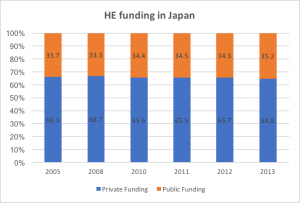
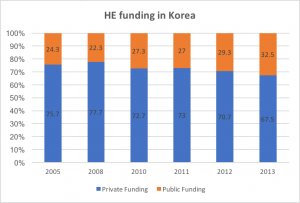
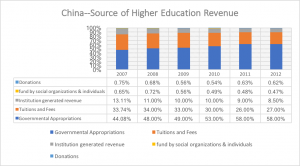
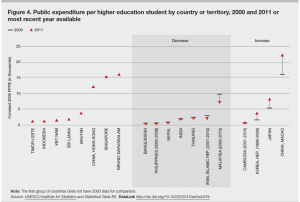

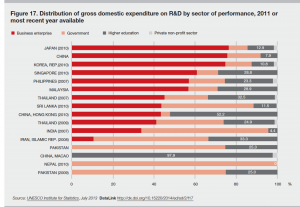
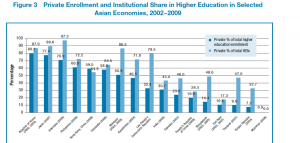
Thank for sharing yingying! I have a question related to your comment, why does the amount of private funding dwarf public funding, even though public funding has increased over the years? Is this driven by demand (i.e. are private institutions preferred by students)? We are yet to have the presentations on China and Korea, but I would be interested in learning what the underlying reasons for this are!
Thanks for the question. Below is the quote I find in OECD,
“At the tertiary level educational institutions in OECD countries are mainly publicly funded, although there are substantial and growing levels of private funding. At this level, the contribution to the costs of education by individuals and other private entities is more and more considered an effective way to ensure funding is available to students regardless of their economic backgrounds.”
Please feel free to let me know if you think it makes sense.
Thank you Yingying!
I just want to add one thing about Japan’s HE budget; the biggest part of HE budget is the subsidy for basic operational cost of national university. But because of severe financial situation and huge national debt, the Ministry of Finance is urging the Ministry of Education to cut this budget and consequently it decreased by 12% over the past 12 years.
This is not unique to HE: K-12 education is also under attack. In this case, you cannot just say “education is important, so let’s increase our budget!”. We have not only to make efforts to sustain necessary budget but also to diversify way of collecting money.
Thanks for sharing your insights. Agree with you. Sometimes the size of the cake(budget) is very limited and the hands are just tight!
I wonder whether the private funding in Japan and Korea include institution generated revenue. I thought the institution generated revenue part is interesting for China. Because nowadays we see a trend of Chinese university opens up their campus for all kinds of activities, even including renting classrooms are outsiders. I wonder does Japan and Korea has the same income?
Thanks for your question. I tend to believe private funding be something such as individual contribution. Institution generated revenue sounds more like public funding to me.
But please let me know if it does not make sense. Happy to further discuss.
So true about China… During my undergrad in Nanjing, I heard the rumor that my university bought the huge piece of campus partially using revenues generated, rental income and internal funds etc.